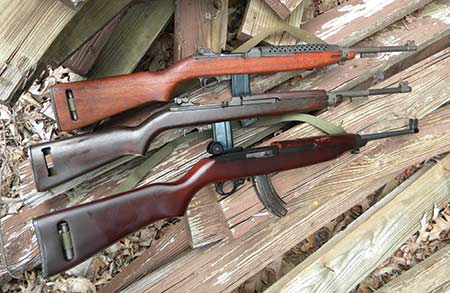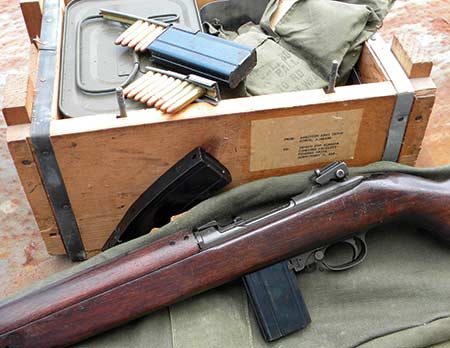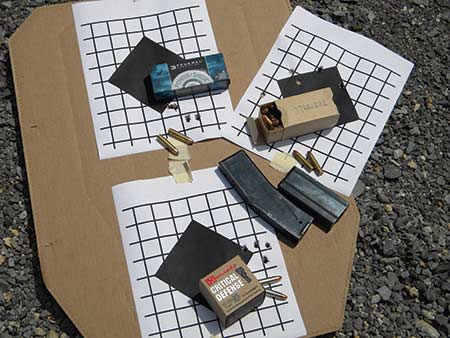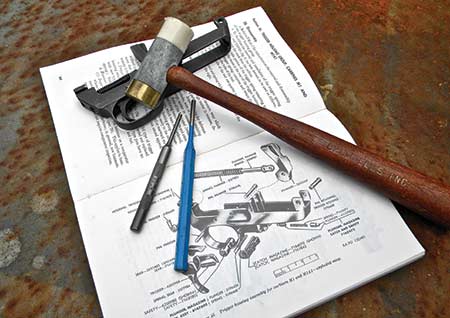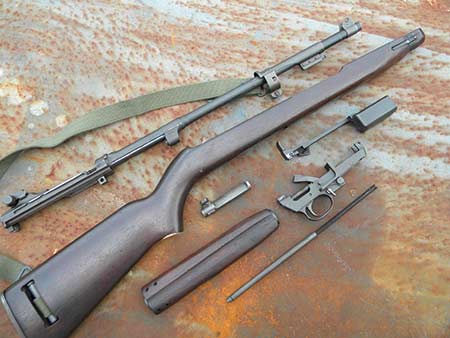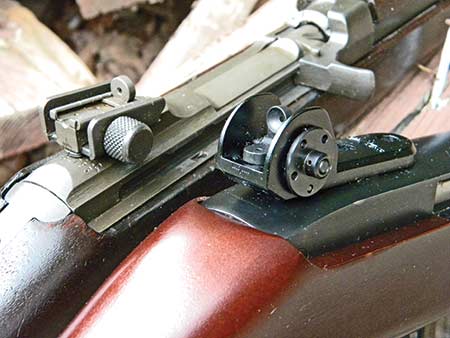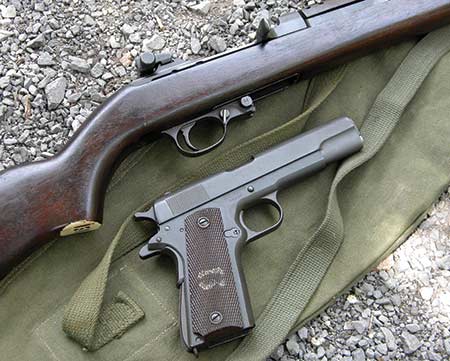Just Enough Gun
The .30 M1 Carbine May Be The Best Home-Defense
Tool You Never Thought Of
I grew up shooting “the carbine.” Back then the term meant the military M1 .30 caliber version, just like saying “forty-five” meant the 1911. The M1 Carbine is lightweight, compact and short-stocked. It has very little recoil and is easy to operate. It was the ideal rifle for a kid to shoot and my dad, who was with the 20th Special Forces Group, always had plenty of ammo.
Easy to Find, Inexpensive
When I was younger, M1 Carbines were very common; even small gunshops— which were everywhere — usually had several in the racks. Carbines were affordable. My first official purchase once I was “of age” was a great military surplus specimen for less than $200. Almost everyone who was into firearms had at least one, and “real” shooters usually had several. Today, very few people are familiar with the M1 Carbine. This is a shame because the “War Baby” still has a lot to offer.
The idea behind the M1 carbine and the M2 select-fire version was to create a small, lightweight weapon to fill the gap between the full-size M1 Garand and the 1911 service pistol. Today it would be called a “PDW” (Personal Defense Weapon). The carbine was chiefly intended for military personnel who couldn’t lug around the heavier, longer Garand while carrying out their primary duties. It was also issued to paratroopers in a folding-stock version which was even more compact and ideal for jumping.
By the time production ceased in 1945, over 6 million carbines had been manufactured by 10 different military contractors. Since WWII, carbines have seen action in Korea and Vietnam — sometimes by both sides — and have been used around the world by over 50 countries. The M1 Carbine was America’s first night or low-light sniper rifle. Although it required a huge backpack battery and the infrared scope was large and bulky, the modified M3 version was used for night fighting in the Pacific during World War II and later in Korea. Even today the M1 carbine and its variants are still in use by more countries than you’d think.
Collectible Or Shooter?
It used to be that if you wanted an M1 Carbine you had to get an old surplus military one — which didn’t necessarily mean it hadn’t been rebuilt or modified — or you bought one of the aftermarket ones, which lacked a little in the reliability department.
Today you have several choices. You can find original “G.I.” carbines, but they are expensive and considered collector’s items rather than “shooters.” Or, you can get “new” carbines from companies such as Inland Manufacturing, Fulton Armory or James River Armory. All of these companies offer quality M1 Carbine repros that are faithful to the originals.
The Power Factor
During its military career, the .30 Carbine was considered by many to be inefficient at stopping the enemy, especially when compared to the .30-06, which offered a lot of penetration and energy. Stopping power was really criticized during the Korean War where the enemy — often hopped up on stimulants — was usually wearing bulky, cold-weather clothing.
However, the ballistics of the .30 Carbine are surprising — the standard military round with a 110-grain bullet at around 1,900 fps generates about 900 foot-pounds of energy. This is better performance than the .357 Magnum, which is an excellent choice for defensive purposes. The problem back then was the FMJ ball ammo used by the military, which basically punches right through an adversary without expanding or fragmenting. Choosing the right ammo is the key to defensive effectiveness, and modern designs with expanding JHP bullets will perform nicely. Some examples? Federal has a 110-grain JSP Power-Shok offering that has an average velocity of 1,990 fps. Hornady offers their FTX version of the .30 Carbine with a 110-grain Flex Tip bullet at 2,000 fps. According to their specs, this round delivers 15 inches of penetration in ballistic gelatin, which provides enhanced stopping power.
The New York Stakeout Squad provides a good example of the M1 Carbine’s effectiveness with “defensive” rounds. In Jim Kirchner’s Tales of the Stakeout Squad (which I highly recommend) Jim Cirrilo called the carbine “one of our best stoppers” adding, “the M1 Carbine was one of our favorite weapons…it was fast to shoot, light recoil, and you had 15 rounds.” The Stakeout Squad hunted bad guys and had good results using JHP bullets in the M1 Carbine.
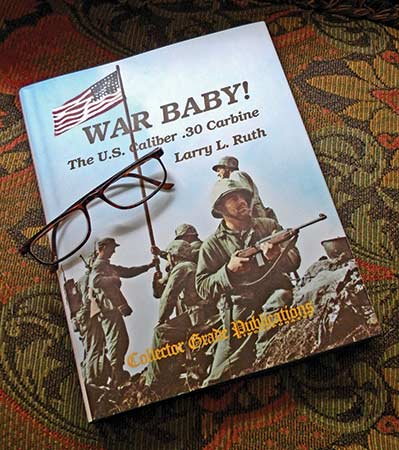
For a complete history of the M1 carbine and its variations, get the “War Baby”
series by Larry L. Ruth. These books give you all the details about the M1 Carbine’s
development, including how to identify all the various manufacturers, their markings
and subtle differences in the parts they produced.
Enough Accuracy
A lot of people complain about the M1 Carbine’s accuracy, but for self-defense you aren’t going to need something that will shoot half-minute groups at 100 yards. First off, it would be very difficult to justify firing on someone at that distance. I’m not saying it doesn’t happen, but it’s very rare. Next, there are very few people who can shoot that well under stress. Most M1 Carbines — which should shoot a 4-inch group or less at 100 — will be more accurate than we can actually realize under stressful conditions.
As with any firearm, you’ll need to experiment to discover exactly what type ammo is going to be the most accurate in your gun. M1 Carbines are particular, and to get the most accuracy possible, you’ll want to try a variety of ammunition under the most consistent conditions to determine which ammo your gun prefers. At the same time you’re checking for reliability. Remember, for defensive purposes everything — ammo included — has to function reliably.
And don’t forget to test out your magazines. M1 Carbine magazines have been made by dozens of different companies, and there are even reports of “fake” military mags which have the proper markings but are definitely not actual GI specimens. From what I know, almost all the 15-round mags are GI; it’s the later 30-rounders you have to be careful with. But regardless of what type mags you have, make sure they function properly.
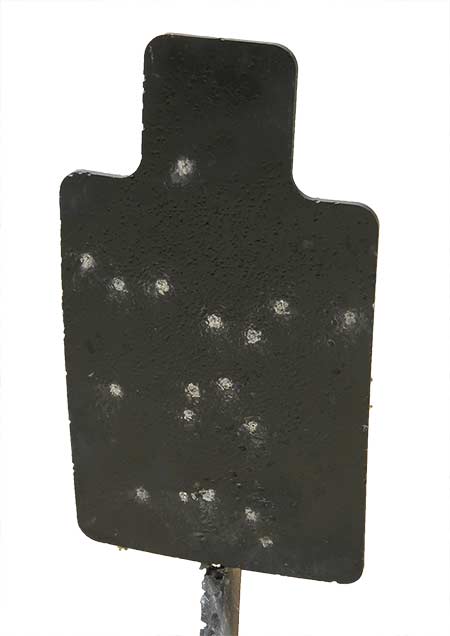
This group was shot rapidfire from the standing position at 100 yards, using the
old Norinco ammo. Tiger was firing as fast as possible while still trying to ensure
hits on the plate. He was also using the iron sights, which he claims is getting
more and more difficult as he gets older! He feels a red-dot or “Scout”-type scope
would definitely help.
Optimizing and Accessorizing
When it comes to aftermarket parts, there aren’t a lot of options. But then you really don’t need to do that much to modify the M1 Carbine for self-defense. I keep mine original, at least as they came to me. If I decided to use them for defensive purposes there would only be a couple of modifications I’d perform.
UltiMak offers a rail system that replaces the factory top handguard, providing the ability for you to set up the M1 Carbine according to your anticipated use (Brownells #100-001-780WB). This mount requires removing the barrel assembly, but it’s not extremely complicated. With a rail you can mount a red-dot sight, which is perfect for defensive use. This same mount also allows you to attach a forward-mounted Scout-type scope with low magnification, which would work well out to the 300-yard limit of the .30 Carbine round. Attach a flashlight and you’ve got a great defensive combination.
For defensive use you’ll definitely want to replace the military-type sling, which is really too short. The Agile Sling from Combat Labs, a two-point sling with a quick release buckle, is simple, versatile and looks right at home on the carbine.
You can leave your M1 Carbine as-is — getting into the retro thing and learning about its history — or can update it into an effective defensive firearm. Like always, there are a lot of different options.
Old School In Session
Most of my training/practice is done with an AR, but every once in a while it’s good to mix it up some and go “old school.” The M1 Carbine is a great firearm. It’s lightweight, reliable and easy to operate. And it’s a good thing to know about the history of our military weapons. I also think it’s extremely important to pass this information and experience on to younger shooters who think all military weapons are black and plastic. There’s just something about metal and wood that feels good.
For self-defense the M1 Carbine is a good option, especially if you live in a state where you can’t have an AR. In today’s shooting world most everyone gets caught up in what’s new and different. Sometimes it’s nice to look back and reconnect with the old stuff, which might work out much better than you imagined.
For a full history of the M1 Carbine, check out the “War Baby” series from Collector Grade Publications: www.collectorgrade.com
The Clone Option
Although it’s not a military weapon another one of my all-time favorite firearms is the Ruger 10/22, which is very similar in size, weight and operation to the M1 Carbine. I have one 10/22 over 30 years old and have shot many thousands of rounds of .22 LR through it. The last time I cleaned it was about 20 years ago. This thing is a shooter.
Next to the AR, the 10/22 is probably the most customized firearm out there. You can set one up for practically any purpose. While the 10/22 is a great carbine, there are two things I don’t like about it — the sights and the stock. Converting your 10/22 into an M1 Carbine clone addresses both of my gripes.
I like having twins of my firearms, and having a .22 clone is great because it allows you to shoot more, plus you can start younger shooters or beginners out with it. There’s almost no recoil and very little noise. After learning the fundamentals, it’s an easy transition to the .30 Carbine.
The issue with the sights is easily corrected by installing Tech Sights’ GI-style aperture sights from Brownells (#100-006-910). These feature an adjustable post front and a flip-aperture rear with windage adjustment. They’re not exactly like the M1 Carbine, but they are close enough for a .22 clone. There are also a variety of rails available for the 10/22, so mounting a red-dot or a Scout-type scope is possible. This allows you to match your clone to your M1 Carbine.
My stock problem with the 10/22 is the concave shape between the heel and toe. To solve this problem I installed a West One Products carbine-style stock from Brownells (#100-005-624) which is a replica stock similar to the M1 Carbine.
The sights, rail and stock are easily installed without any special skills or tools.
While changing stocks I also installed a custom trigger and extended mag release. There are a variety of different triggers and accessories for the 10/22 available from Brownells. For detailed information on more extensive modifications like trigger installation or replacing the magazine catch, Brownells has books and DVD’s on the 10/22.
For magazines I use Ruger’s 25-rounders. Since the purpose of having a .22 is shootin’, why would you want to have to reload after only 10 rounds (which is what the standard factory mags hold)? Ruger’s 25-rounders are available from Brownells ( #780-001-311WB) are reliable and extend your shooting pleasure. There’s also a shorter 15-round version (#780-001-369WB).
Once you get everything set up it’s time to hit the range. What, more shooting? Yes, but that’s a good thing, right? First, you’ll need to zero the new sights. I suggest using affordable cheap ammo for the zeroing process. Then, once you’ve got a decent zero, start testing different ammo. Rimfires are definitely ammo sensitive, so for best accuracy and reliability, you’ll need to test a lot of different ammo (yep, more shooting required).
When I find the most accurate ammo (usually more expensive than plinking ammo!), I perform a final zero with it. Then I’ll test the various other types of ammo to find the one that shoots closest to the “final zero” super-accurate stuff. That’s what I’ll use for high-volume fun.
Reconnecting
My dad’s two favorite firearms were his 1911 and the M1 Carbine. Every time we went shooting these two firearms were always included; these are the guns I grew up shooting, cleaning and taking care of. When he passed on several years ago, all his firearms came to me. For this article I pulled out dad’s M1 to shoot; the first time I’ve shot “his” carbine in over 40 years. Shooting it reminded me of our shared love for firearms. For me, some of the best times I spent with dad were when we were shooting. I never turned down the chance to go with him.
Since I had his M1 Carbine out, I couldn’t help but dig through the safe for his 1911 to also run a few mags through. I was a kid again, and could feel dad standing behind me, offering tips and coaching me on how become a better shooter. It was one of those magical times, when dad talked to me like another man instead of his son, who still had a lot of growing to do.
Afterward we would spend time in his gunroom, cleaning the firearms with him telling me stories. That night I’d go to sleep. My eyes were closed, but in my mind I was seeing the target, feeling the recoil, smelling gunpowder and hearing the words of my father and trying to remember the wisdom he was passing along.
It was a good day on the range.
Brownells
www.brownells.com
Inland Manufacturing
www.inland-mfg.com
James River Armory
www.jamesriverarmory.com/
Fulton Armory
www.fulton-armory.com/
Remington Ammo
www.remington.com/ammunition
Hornady Ammo
www.hornady.com/ammunition
Agile Slings (email)
[email protected]
